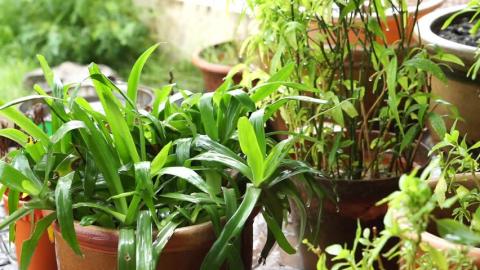Fertilizing Houseplants

Those who own houseplants tend to fall into two separate camps; those who kill their plants with kindness and those who let them suffer through neglect. When it comes to fertilizing, I have found that less is often more. Plants that are over-fertilized can out-grow their pots and spaces too rapidly, or in severe cases, become stunted and even die. Applying the proper amount of fertilizer at the proper times of year is essential to promoting the health of your plant.
Timing
In winter, most houseplants go through a rest period. During these months, growth slows as plants are exposed to lower temperatures and less natural light. As a rule of thumb, only fertilize houseplants when they are actively growing, because plants only use added nutrients when they are producing new leaves, roots, etc. This means putting away the fertilizer from October until the spring. March is a good time to start fertilizing, and most houseplants will benefit from an application once every 1 – 3 months depending on which formulation is being used.
Choosing a fertilizer
There are many commercially available fertilizers that will work very well when it comes to houseplants. When you’re making a choice, pick a product with a balanced ratio of the three macronutrients: nitrogen (N), phosphorus (P), and potassium (K). Another consideration is how long it takes the fertilizer to become available to the plant. Most liquid or powder fertilizers provide nutrients that are immediately accessible to plants, while some pelletized fertilizers are “slow-release” and break down gradually over weeks or months. Whatever product you use, make sure you follow the directions and never use a stronger mixture than is recommended on the label.
Leaching
Many fertilizers are full of soluble salts, which can build up in the soil over time. Applying fertilizer too often or too heavily can harm plants. When there is too much salt in the soil, plants have a difficult time taking up the water they need. Excessive salts can even burn sensitive root tips and leaf margins, leaving you with a sad, stunted plant.
Fortunately, these issues can be avoided by leaching pots every four months or so. To leach your houseplants, flush your pots with copious amounts of fresh water until it drains freely from the bottom of the pot. A good way to do this is by placing plants in a sink or bathtub, running water through the pots, and letting them drain thoroughly. If your plants are too big to move, you can leach them in place by pouring large amounts of water through the pots and immediately emptying the saucers.
If your houseplants seem stunted or the leaves are showing yellow or purple tints, chances are they are in need of a good dose of balanced fertilizer. While fertilizer alone may not be enough to revitalize your plants, it should give them a boost at the start of the growing season.